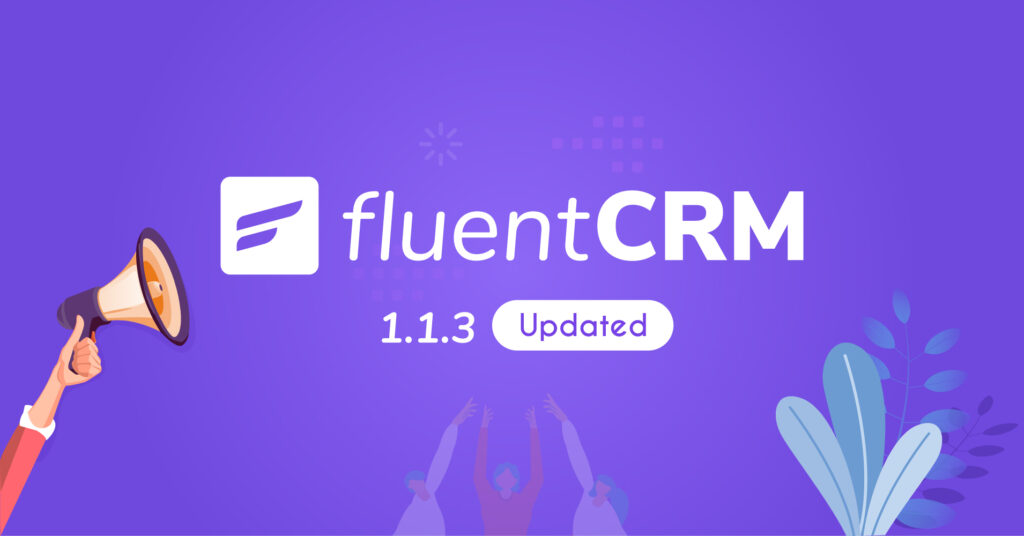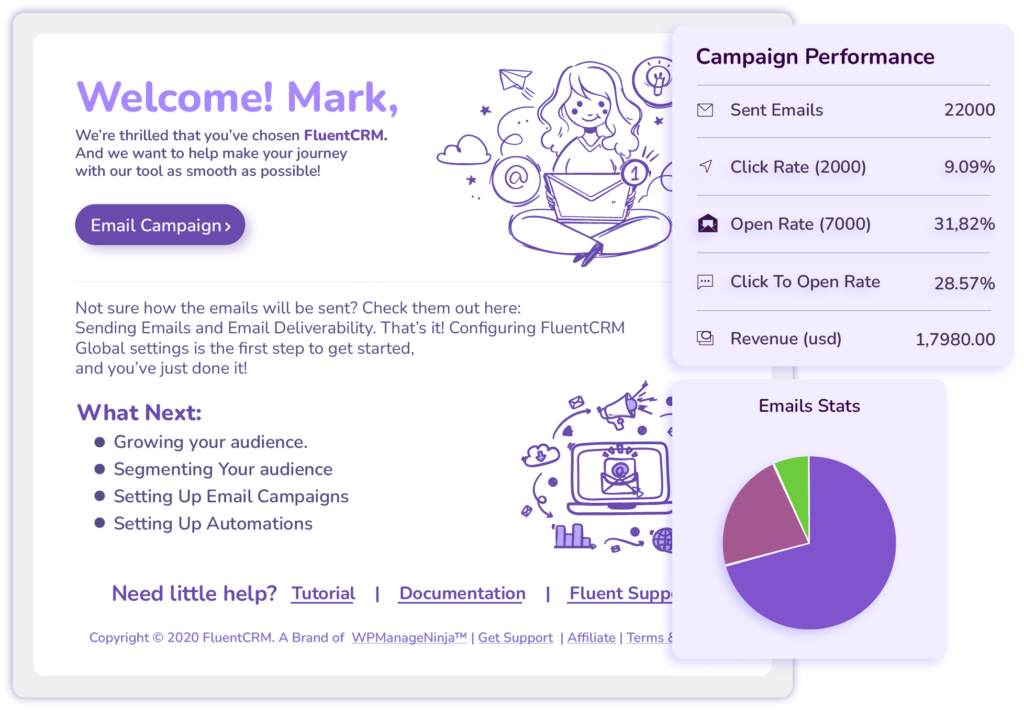![transactional email vs. marketing email [explained] (1)](https://fluentcrm.com/wp-content/uploads/2023/08/Transactional-Email-vs.-Marketing-Email-Explained-1.jpg)
Transactional and marketing emails are like the two sides of a single coin. They may be different in nature, but they’re both integral parts of any successful email marketing strategy. So what’s the difference?
Transactional emails are often the conversation starters, they are like the friendly neighbor saying hello. With an average open rate of 80-85%, transactional emails can help you establish that initial connection with your audience. On the other hand, marketing emails are the engagement builder. With open rates typically around 20-25%, they can help you keep people interested and engaged in your business.
That said, transactional emails and marketing emails complement each other. In this article, we’ll dive into the differences between transactional emails and marketing emails and see how they work together to elevate your email marketing game. We’ll also look into a few examples of each so you can truly understand how other businesses use them.
It’s going to be an insightful journey – let’s dive in!
What is a Transactional Email?
A transactional email is a type of automated email triggered by a user’s action or transaction. Unlike marketing emails, which focus on promotional content, transactional emails deliver essential information based on user interactions. Examples of transactional emails include—
- Order confirmation emails
- Shipping notifications
- Password reset emails
- Account verification emails
- Order receipt emails
- Subscription confirmations etc.
A transactional email typically carries transactional content, the exact information the users expect or need. Since the recipients explicitly requested this information, they are more inclined to open these emails. For the same reason, Gmail and other popular email clients also treat transactional emails worthy of a “primary tab” placement. Hence, the astonishing 80-85% open rate!
Additionally, transactional email content incorporates a heavy touch of personalization, further increasing the recipient’s user experience and guiding them toward the next steps. Businesses send transactional emails through SMTP relay or APIs, ensuring efficient and reliable delivery.
What is a Marketing Email?
A marketing email is a targeted email sent by businesses to promote products, services, events, or initiatives to a specific audience. The primary aim of marketing emails is to engage recipients and prompt them to take action, such as making a purchase, signing up for a webinar, or subscribing to a newsletter. Examples of marketing emails include—
- Newsletters
- Promotional offers
- Product announcements
- Abandoned cart emails
- Re-engagement emails
- Cross-Sell and Upsell Emails
- Event invitations, and so on.
Marketing emails are typically sent to recipients acquired through lead generation efforts or opt-in subscriptions. Unlike transactional emails, which are triggered automatically, marketing emails are strategically timed and distributed to achieve commercial goals. They play a crucial role in email marketing campaigns, driving conversions and fostering customer relationships. Businesses often utilize email marketing solutions like FluentCRM to streamline email creation, delivery, and tracking.
Transactional Email vs. Marketing Email
A transactional email delivers information about an action the recipient has already taken, while a marketing email aims to prompt the recipient to take a specific action you desire. Transactional emails focus on addressing user needs and facilitating actions, such as purchase confirmations or account notifications. Conversely, marketing emails strategically promote products or services to drive engagement and conversions.
Despite sharing similarities, both transactional and marketing emails serve their own purposes in your communication strategy. You can’t replace one with another, nor can you do without one of them. Understanding their differences can you optimize your email campaigns for better results. Let’s dive into the key contrasts:
Purpose
The first thing the transactional and marketing emails differ in is their respective purposes. While transactional emails serve purposes specified by the customers, marketing emails are sent by the company for their own designated purpose.
- Transactional emails: Transactional emails have a clear-cut goal, which is to facilitate specific actions or transactions. These emails are triggered by user interactions, such as purchases, password reset requests, or appointment bookings. Their primary goal is to provide information and confirmation, ensuring a smooth user experience.
- Marketing emails: In contrast, marketing emails are persuasive and designed to drive engagement and conversions . They showcase products, promotions, or events, encouraging recipients to take action. Marketing emails are highly personalized and specifically segmented toward their receiver to maximize their impact.
Objectives
Another key point where transactional and marketing emails part their ways is their objectives. Where transactional emails are primarily user-centric, marketing emails focus on conversion.
- Transactional emails: These emails prioritize user needs and experiences above all. They deliver essential information as the user takes an action, such as signing in or making an order. The primary focus is on clarity and functionality, minimizing the risk of frustrating the user. Transactional emails shape how the user experience will be to a great extent.
- Marketing emails: Marketing emails are sent to generate maximum user conversions. Marketing email content aims to attract, captivate, and persuade recipients to engage with your brand’s offerings. Though user experience matters, the primary goal of a marketing email is to drive conversion and gain valuable actions from the user.
Content
Both Transactional and marketing emails have fundamentally different inner body content. While one informs the customers about their purchases and actions, the other promotes various offerings you have for the potential customers.
- Transactional emails: Transactional emails are informational. Meaning, it’s the ideal vessel through which information gets delivered to its recipient. For example, transactional emails provide the specific details of a transaction, like order summaries or account confirmations. The inner content of transactional emails is transaction-centric and usually doesn’t contain any promotional elements. However, it is possible to put clever CTAs or marketing materials inside transactional emails.
- Marketing emails: Just like the name suggests, marketing emails are promotional in nature. They highlight your products, services, or special offers, with the help of persuasive language and calls-to-action (CTAs). The primary focus of marketing emails is to drive prospects to engage further with the brand and eventually make the purchase. Marketing emails are often sent following an email sequence, with the ultimate goal of making a conversion.
Frequency and Timing
Timing and frequency play a vital role in all kinds of emails. And this is where transactional and marketing emails need to be handled differently.
- Transactional emails: Transactional emails, or triggered emails are ‘triggered’ instantly based on a specified user action. For example, an order confirmation email is sent as soon as a transaction is completed. The timing is crucial here and you have to ensure your customers receive timely information. If not timed correctly or triggered accordingly, your brand reputation might be in jeopardy.
- Marketing emails: Marketing emails on the contrary are timed and strategized based on factors that are specific to a business. The factors to consider are – user engagement patterns and optimal time slots for delivery to name a few. The re-engagement emails that you send are also part of marketing emails. The planning and the strategies directly affect the open rate and click-through rate of a given email campaign.
Scope of Personalization
Due to their inept nature, the chances of personalizing the content of transactional and marketing emails are different too. Of course, both kinds of emails need to be personalized. But to what extent?
- Transactional emails: Transactional emails are often short in nature. Being centered around a specific transaction, there are a few things to include in a transactional email— the recipients’ names, order numbers, and shipping and transaction details. The good thing is— all the data needed for the personalization is provided by your customer. So you don’t need to put extra effort into personalizing a transactional email.
- Marketing emails: Marketing emails leverage email personalization to a greater extent. In marketing emails, factors like recipients’ preferences, past interactions, demographics, and browsing behaviors are considered to deliver content that resonates with individual recipients. Although it requires a considerable amount of effort, this kind of personalization approach enhances the chance of better user engagement and conversion.
Examples of Transactional Emails
It’s important for businesses to ensure that transactional emails are well-designed, clear, and include all necessary information. However, they should also be careful not to include marketing content in transactional emails, as this can confuse recipients and potentially lead to deliverability issues.
While you may already have a good grasp of transactional emails and their typical structure, the common tendency is to keep transactional emails as they are. However, if you can use these emails strategically, they can be a good source of additional engagement.
Let’s look at a few instances of transactional emails from prominent brands, showcasing common types and elements that enhance user experience!
Mailchimp – Registration Confirmation Email
One of the most common types of transactional email is the registration confirmation email. If you think, “Oh well, those emails are sent automatically and I don’t need to worry about them”, hold on a minute!
Indeed, crafting a registration confirmation email isn’t rocket science, but you can surely take inspiration from Mailchimp. Their email is short, concise, and to the point, and comes with a clear button to confirm the subscription confirmation.

Reddit – Password Reset Email
Regardless of your business’s niche, you’ll have to deal with numerous password reset requests every day. While the transactional content of a password reset email typically follows a straightforward approach, there’s always an opportunity to infuse branding. Here’s how Reddit has effectively incorporated branding into their password reset email—

Adidas – Cart Abandonment Reminder
Customers viewing products and then leaving your website is a common scenario for almost every business owner. Fortunately, there’s a proven way of bringing them back.
Cart abandonment reminder emails can do wonders if you know how to utilize them. According to Barilliance, businesses enjoy an impressive 18% conversion rate for cart abandonment reminder emails sent!
Adidas does this in a fun way. Asking the recipients if their “WIFI is Okay” is a subtle, yet effective way to get them to open their cart abandonment email and complete their purchase.

Examples of Marketing Emails
An ideal marketing email contains a mix of informative content and persuasive elements, such as compelling visuals, well-crafted copy, and clear calls to action (CTAs). These emails are personalized to some extent, addressing the recipient by name and tailoring the content to their interests or past interactions with the brand.
Let’s take a unique approach to learning about effective marketing emails. Instead of simply discussing strategies, let’s explore real-world examples from leading brands!
Nike – Capitalizing on Father’s Day
Different occasions are just the prime time for sending marketing emails. If you are wondering whether your product fits the occasion or not, just forget about it. Believe in Nike’s slogan, Just Send It!

Starbucks – Utilizing Offers
While the average open rate for marketing emails is just about 20-25%, it’s surprisingly higher when they incorporate an offer. This is why Starbucks is sending offers through its emails, despite being an established brand.

Canva – Product Improvements
Product improvements— sounds like an unconventional marketing content?
Well, once you have made a name for your brand, your product upgrades can be great marketing content. Consider this, those who trust you, always have one or two suggestions. So when you reach out to them with product improvement news, they’ll surely check if you listened.
That’s why Canva chose to let their users know about their new improvements. This doesn’t just help them market their products but also keeps the existing customers in the loop —acting both as a customer retention email as well as product promotion for those who haven’t signed up yet.
Email Delivery Guidelines for Transactional and Marketing Emails
With Google and Yahoo announcing new email deliverability rules, bulk emailers have to be more careful than ever. Now that we’re done with the comparison, it’s time to focus on something important— email delivery guidelines.
Since transactional and marketing emails have different appeal to the recipients, email clients like Google and Yahoo treat them differently. Just as we mentioned, email clients mostly place transactional emails into the primary tab— ensuring maximum chances of getting your message seen. However, if you send both marketing emails and transactional emails from the same email address, email clients may start treating your transactional emails as marketing emails.
You wouldn’t want that to happen, right?
Google suggests an easy way—
Separate Email Addresses for Transactional and Marketing Emails
According to Google’s bulk email guidelines—
“If you send both promotional email and transactional email relating to your organization, we recommend separating email by purpose as much as possible.”
This can be done by using separate email addresses for each type of email. For example, you can send transactional emails from [email protected] and marketing emails from [email protected].
How to Separate Transactional and Marketing Emails?
WordPress provides the simplest way to separate transactional and marketing emails. If you’re using a Multiple Connection-supported plugin like FluentSMTP. You can simply create a new email identity from your email service provider (Any email service like Amazon SES, MailGun, SendGrid, or Postmark allows for creating multiple Email IDs).
Then, set up both emails inside FluentSMTP.

Next, go to FluentCRM Settings>Email Settings and set your marketing email sender address.

Note that, other plugins use your WordPress admin email to send notifications and transactional emails. So make sure your admin email is different than the email address you’ve configured with FluentCRM. To check your admin email address, go to Settings>General from your WordPress admin dashboard.

Once you’ve configured these, your transactional emails and marketing emails will start sending from different addresses.
Key Takeaways: Transactional vs. Marketing Emails
To summarize, transactional emails deliver essential information based on user actions, while marketing emails aim to engage and prompt specific actions. To optimize your emails for deliverability and effectiveness:
- Use transactional emails for user-centric information
- Employ marketing emails for persuasive content and conversions
- Separate sender IDs for transactional and marketing emails to enhance deliverability and clarity
By understanding and leveraging the distinctions between transactional and marketing emails, you can improve user experiences and drive better results in your email campaigns.
Hopefully, this blog was helpful enough to help you understand the differences between transactional and marketing emails. Now that you know how to make the most of them, start utilizing these two types of emails appropriately and according to your users’ needs. If you still have any confusion, don’t forget to reach us in the comments!









Leave a Reply